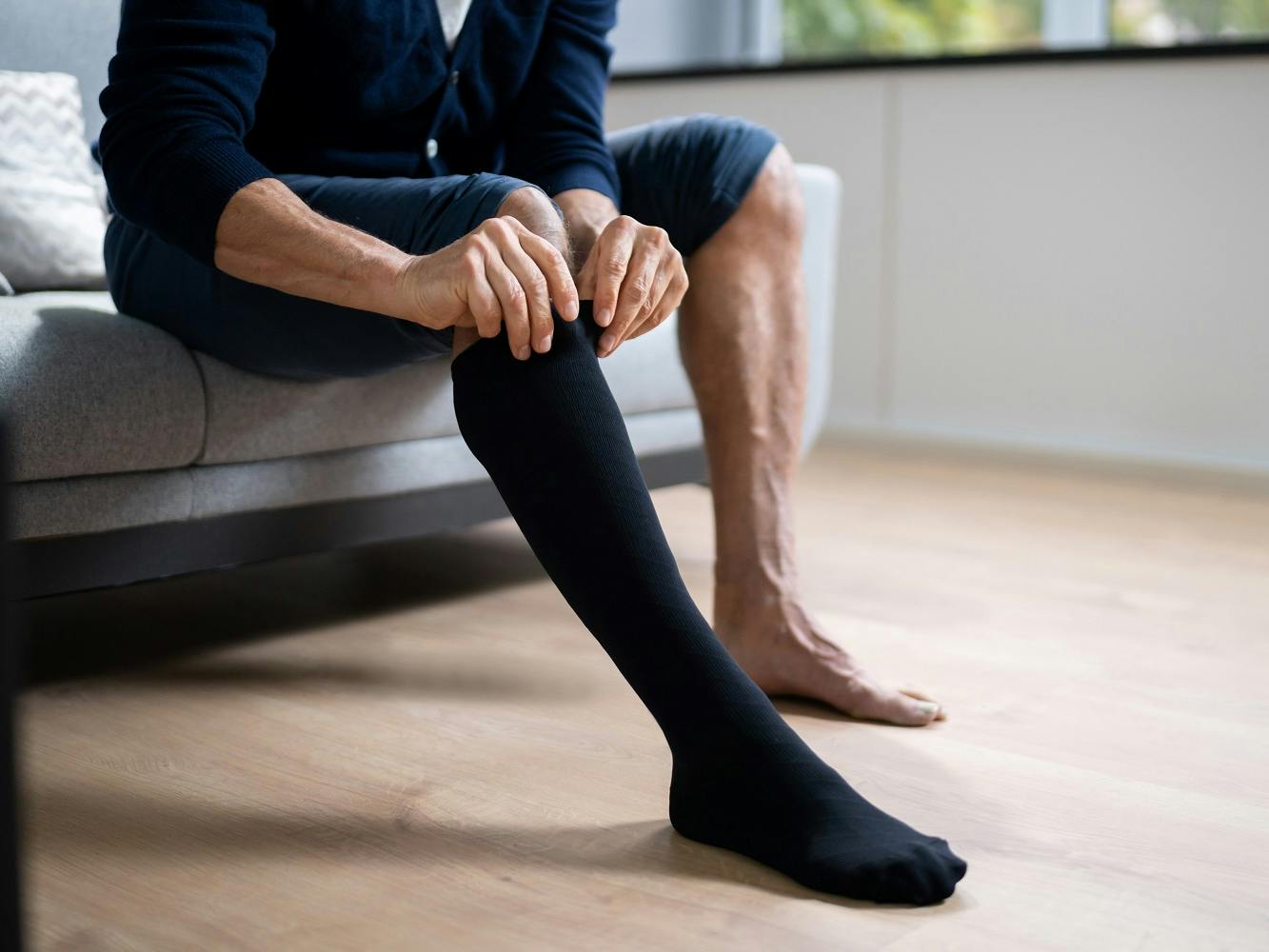
Compression stockings have a variety of uses, but Medicare only covers them to treat one issue – venous stasis ulcers.
Compression stockings help improve blood flow, lessen pain and swelling in the legs, and lower the chances of getting certain types of blood clots. Many people wear compression stockings both for comfort and help prevent serious medical conditions.
These stockings come in different sizes and strengths based on your needs, and they can be purchased over the counter at a local drug store or online. If you buy compression stockings, you’ll likely have to pay for them out-of-pocket because they aren’t usually covered by Medicare. Of course, there are some exceptions, so read on to learn more.
Medicare coverage for compression stockings
Typically, Medicare does not cover compression stockings. That’s because they do not meet the definition of durable medical equipment (DME), covered by Medicare Part B (medical insurance).
Durable medical equipment is equipment and supplies that are:
- Durable (can withstand repeated use)
- Used for a medical reason
- Used in your home
- Expected to last at least three years
- Typically, only useful to someone who is sick or injured
Some examples of DME include canes, wheelchairs, hospital beds, blood sugar meters and test strips, walkers, and oxygen equipment.
Because compression stockings are usually used for preventive purposes and not considered DME, you would have to pay for 100% of the cost out-of-pocket.
However, there is one exception: When you have a venous stasis ulcer in your leg, compression stockings may be covered. A venous stasis ulcer occurs due to poor circulation in your leg, and a doctor may instruct you to apply a compression stocking over the wound dressing. For Medicare to cover compression stockings, the following must apply:
- A physician or health care provider must certify the beneficiary has an open venous stasis ulcer and that removing the damaged, dead, or infected tissue is medically necessary.
- The gradient stocking must be proven and compress between 30mm Hg and 50mm Hg.
- The compression stocking must be used in conjunction with a surgical dressing.
If a compression stocking is considered medically necessary by your doctor, they will write a prescription for one that applies a specific amount of pressure. Then, they can file a claim for the stocking. As long as your doctor and the DME suppliers are enrolled in Medicare and accept assignment, you would only owe 20% of the Medicare-approved amount (after meeting the Part B deductible, $226 in 2023).
Do Medicare Advantage plans cover compression stockings?
Medicare Advantage (Part C) plans cover everything Medicare Part A and Part B do (and more), so it’s possible they may also cover compression stockings.
As with Original Medicare, compression stockings would also be covered if they meet the criteria for medical necessity in conjunction with a venous stasis ulcer.
Look for an Advantage plan that covers compression stockings
Additionally, in 2019, the Centers for Medicare & Medicaid Services (CMS) passed rules that allow MA plans to expand covered benefits to include things like an “over the counter” benefit or flex card. While these over-the-counter benefits can vary by plan, they typically provide a certain amount of money to beneficiaries each quarter or year to use for over-the-counter health purchases such as:
- Medications
- Thermometers
- First aid supplies
In some cases, compression stockings may fall under this benefit.
What are compression stockings?
Compression stockings are specially made, snugly-fitting, stretchy socks that gently squeeze your leg. The pressure that is put on your leg helps your blood vessels to work better – the arteries that take oxygen-rich blood to your muscles can relax, so blood flows more freely and easily. This makes it harder for blood to pool in your veins and make a clot, which could cause a number of serious problems.
What are compression stockings used to treat?
People who can or should use compression stockings for medical reasons include those who:
- Have or are at risk for circulation problems, including DVT, varicose veins, or diabetes
- Have just gotten surgery
- Can’t leave their bed
- Have a hard time moving their legs
Additionally, people who stand all day, spend long stretches of time on airplanes, are athletes, and are pregnant could all benefit from wearing compression stockings.
Not only can compression stockings help with circulation in the legs, but they can also keep legs from getting tired and achy, prevent swelling in feet and ankles, and help prevent and treat spider and varicose veins.
Types of compression stockings
There are three primary types of stockings:
- Graduated compression, or compression stockings, are tighter around your ankle and get looser as they move up your leg. They can be found in a wide range of tightness.
- Compression sleeves, which are just the tube part of the sock without the foot.
- Thrombo-embolic deterrent (TED) hose, or anti-embolism stockings, are designed for after surgery and/or when you need to stay in bed to maintain blood circulation and lower the odds of swelling.
Stockings for DVT typically go just below the knee, but you can also get thigh-high and waist-length ones as well.
If you’re purchasing compression stockings, it’s important to find a pair that fit you well, are the correct length, and provide the correct compression. How much compression you need depends on the type of condition you have, and there are options of low compression, medium compression, moderate to high compression, and firm compression.
If your compression stockings are medically necessary and covered by Medicare, your doctor or staff at a DME or medical supply store will take measurements and help you find the right fit.
How much do compression stockings cost?
Compression stockings can range in cost depending on whether they are standard fit or custom fit. They can cost as little as $10 per pair or up to $200 or more.
You can save money with the right Medicare plan – especially one that includes over-the-counter benefits. Our Find a Plan tool makes it easy to review your options. Just enter your zip code to start comparing costs and coverage for Medicare plans in your area.
Additional resources
Find a Medicare plan
Internal Website Link
Medicare.gov: Durable Medical Equipment Coverage
External Website Link



